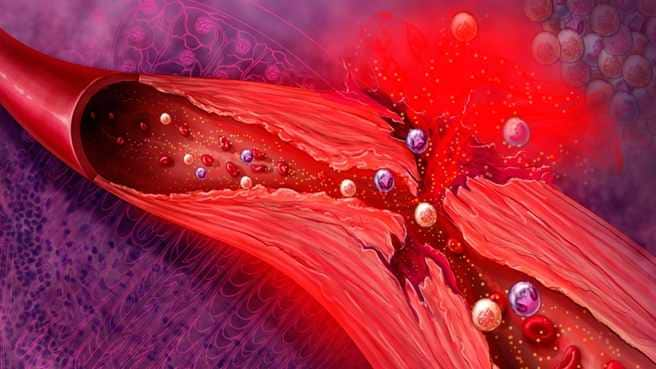Overview
Takayasu's arteritis (tah-kah-YAH-sooz ahr-tuh-RIE-tis) is a rare type of vasculitis, a group of disorders that causes blood vessel inflammation. In Takayasu's arteritis, the inflammation damages the large artery that carries blood from your heart to the rest of your body (aorta) and its main branches.
The disease can lead to narrowed or blocked arteries, or to weakened artery walls that may bulge (aneurysm) and tear. It can also lead to arm or chest pain, high blood pressure, and eventually heart failure or stroke.
If you don't have symptoms, you may not need treatment. But most people with the disease need medications to control inflammation in the arteries and to prevent complications. Even with treatment, relapses are common, and your symptoms may come and go.

Large arteries
Takayasu's arteritis is a form of vasculitis — inflammation of the blood vessels — that damages the large arteries, especially the aorta.

Chambers and valves of the heart
A typical heart has two upper and two lower chambers. The upper chambers, the right and left atria, receive incoming blood. The lower chambers, the more muscular right and left ventricles, pump blood out of the heart. The heart valves, which keep blood flowing in the right direction, are gates at the chamber openings.
Symptoms
The signs and symptoms of Takayasu's arteritis often occur in two stages.
Stage 1
In the first stage, you're likely to feel unwell with:
- Fatigue
- Unintended weight loss
- Muscle and joint aches and pains
- Mild fever, sometimes accompanied by night sweats
Not everyone has these early signs and symptoms. It's possible for inflammation to damage arteries for years before you realize something is wrong.
Stage 2
During the second stage, inflammation causes arteries to narrow so less blood and oxygen and fewer nutrients reach your organs and tissues. Stage 2 signs and symptoms may include:
- Weakness or pain in your limbs with use
- A weak pulse, difficulty getting a blood pressure or a difference in blood pressure between your arms
- Lightheadedness, dizziness or fainting
- Headaches or visual changes
- Memory problems or trouble thinking
- Chest pain or shortness of breath
- High blood pressure
- Diarrhea or blood in your stool
- Too few red blood cells (anemia)
When to see a doctor
Seek immediate medical attention for shortness of breath, chest or arm pain, or signs of a stroke, such as face drooping, arm weakness or having difficulty speaking.
Make an appointment with your doctor if you have other signs or symptoms that worry you. Early detection of Takayasu's arteritis is key to getting effective treatment.
If you've already been diagnosed with Takayasu's arteritis, keep in mind that your symptoms may come and go even with effective treatment. Pay attention to symptoms similar to those that occurred originally or to any new ones, and be sure to tell your doctor promptly about changes.
Causes
With Takayasu's arteritis, the aorta and other major arteries, including those leading to your head and kidneys, can become inflamed. Over time the inflammation causes changes in these arteries, including thickening, narrowing and scarring.
No one knows exactly what causes the initial inflammation in Takayasu's arteritis. The condition is likely an autoimmune disease in which your immune system attacks your own arteries by mistake. The disease may be triggered by a virus or other infection.
Risk factors
Takayasu's arteritis primarily affects girls and women younger than 40. The disorder occurs worldwide, but it's most common in Asia. Sometimes the condition runs in families. Researchers have identified certain genes associated with Takayasu's arteritis.
Complications
With Takayasu's arteritis, cycles of inflammation and healing in the arteries might lead to one or more of the following complications:
- Hardening and narrowing of blood vessels, which can cause reduced blood flow to organs and tissues.
- High blood pressure, usually as a result of decreased blood flow to your kidneys.
- Inflammation of the heart, which may affect the heart muscle or the heart valves.
- Heart failure due to high blood pressure, inflammation of the heart, an aortic valve that allows blood to leak back into your heart, or a combination of these.
- Stroke, which occurs as a result of reduced or blocked blood flow in arteries leading to your brain.
- Transient ischemic attack (TIA), which is also called a ministroke. transient ischemic attack (TIA) serves as a warning sign because it produces symptoms similar to a stroke but doesn't cause permanent damage.
- Aneurysm in the aorta, which occurs when the walls of the blood vessel weaken and stretch, forming a bulge that has the potential to break.
- Heart attack, which may occur as a result of reduced blood flow to the heart.

Aortic aneurysm and aortic dissection
An aortic aneurysm occurs when a weak spot in the wall of your aorta begins to bulge (left). This can occur anywhere in your aorta. Having an aneurysm increases the risk of an aortic dissection a tear in the lining of the aorta, shown in the image on the right.
Pregnancy
A healthy pregnancy is possible for women with Takayasu's arteritis. But the disease and drugs used to treat it can affect your fertility and pregnancy. If you have Takayasu's arteritis and are planning on becoming pregnant, work with your doctor to develop a plan to limit complications of pregnancy before you conceive. See your doctor regularly during your pregnancy for checkups.
